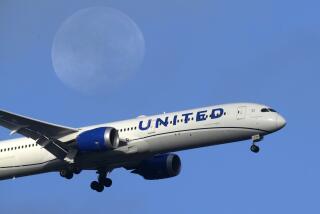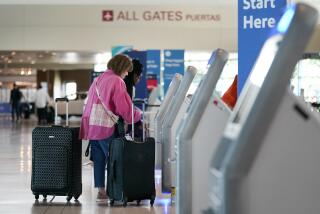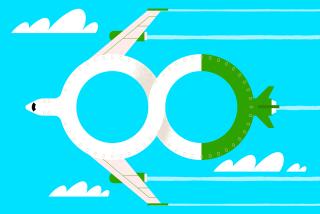Frequent-Guest Plans Have Staying Power
- Share via
Miles or points? That’s the quandary facing frequent business travelers checking in at the hotel counter.
Unlike airline frequent-flier programs, hotel frequent-stay programs are far from standardized.
Given the choice, about 70% of customers would choose miles over hotel points because it’s easier to accumulate them and the rewards are easier to understand, said Randy Petersen, publisher of the Colorado-based InsideFlyer newsletter. “Miles are still king.”
But they are not necessarily the best value. “Hotels, in my mind, are the Rodney Dangerfield of frequent-travel programs,” Petersen said. “As a value proposition, hotels hold more value than airlines.”
For example, hotel points often have more options for redemption than do airline miles. You can cash in points for free rooms, free airline tickets, free car rentals and even merchandise.
Also, a free room stay can be more valuable than a free airline ticket. With a little advance planning, you can usually get an airline ticket almost anywhere in the United States for a few hundred dollars or less. But if you stay several nights, you can easily spend double or triple that on hotel rooms.
The hotel industry in general hasn’t been effective in communicating the value of these programs to their frequent guests, said Rick Barlow, president of Frequent Marketing Inc., an Ohio-based company that helps develop frequent-use programs for companies. “Hotels made a mistake along the way by abandoning the value of their own product,” he said.
With a few exceptions, most hotel programs offer a choice between frequent-flier miles and hotel points. That automatically subjugates the hotel’s marketing efforts to whatever the airlines are doing, Barlow said.
Hotels have missed out on a great marketing opportunity, he said. “Step No. 1 should be to exploit what’s been there all along: information.”
Frequent-guest programs provide hotels with databases full of information about the habits of their best customers, but hotels typically haven’t used that information to communicate with their guests, Barlow said.
Barlow uses himself as an example. As an experiment, he spread his hotel stays--about 50 nights a year--among a number of different hotels last year instead of spending all of them at Sheraton, as he had previously. None of the hotel chains seemed to notice the change in his habits, which means they missed an opportunity to influence his behavior, he said.
*
One reason hotels haven’t aggressively promoted frequent-stay programs is that many individual properties are owned by franchisees, unlike an airline, which is wholly corporate-owned, Petersen said.
“You always have a problem getting hotel owners to participate,” he said. “There’s a struggle between what the corporation would like to do and what the franchisee owners want to do.”
That could be changing, however. One indicator that hotels are taking a renewed interest in their frequent-guest programs is that several hotels have stepped up their chain-wide marketing efforts through co-branded credit cards.
Sheraton Hotels, for example, recently launched a co-branded credit card with American Express that offers bonus “ClubMiles” for every dollar charged at participating Sheraton properties. The club miles can be redeemed for free stays, rentals or airline miles. Hilton already has a co-branded American Express card, and Marriott has relaunched a Gold Visa card.
One obstacle to making hotel programs as widely used as airline programs is that people appear to be less loyal to hotel companies than they are to car rental companies or airlines, Petersen said. People tend to choose their hotel based on location, price and convenience rather than potential reward.
*
Another obstacle is that hotel programs remain more complicated and difficult to understand.
In airline programs, you generally earn one mile for every mile you fly, regardless of the price of the ticket. That’s fairly standard among airlines. With hotels, however, the conversion rates vary. Holiday Inn, for example, rewards one point per dollar spent. Hyatt gives five points per dollar, and Marriott gives 10 points. Hilton, Red Lion and Westin all allow “double dipping,” awarding both points and miles for each stay.
“In the hotel industry, there is no common currency for people to decide which is a better deal,” said Petersen of InsideFlyer. “That’s why it’s so confusing.”
At Hilton, for example, it takes 20,000 points to earn one weekend night. At Hyatt it takes 8,000 points to earn a weekend night. And at Red Lion, you earn one weekend night for every 10 nights you’ve stayed.
That degree of complexity may explain why a recent survey by the U.S. Travel Data Center showed about 34% of business travelers belonged to an airline frequent-flier program but only 16% belonged to a hotel guest program.
With a little diligence, however, you can make such programs worth the effort to understand. According to Consumer Reports Travel Letter, the payoff for participating in a hotel program ranges from 4% to 33%, depending on the chain and how you use the points. The payoff for using airline frequent-flier mileage programs varies from 5% to 20%.
Even if you don’t patronize a hotel chain often enough to earn a free stay, you may get other perks, including free breakfasts, quick check-ins and late checkouts.
There’s another way to look at the value of airline miles versus hotel points.
“You might spend 48 hours with a hotel and an average of 1 1/2 hours on the airline getting there,” said Petersen. “I’d rather be pampered for 48 hours than 1 1/2 hours.”
Carol Smith is a freelance writer based in Seattle. If you have suggestions or comments on Executive Travel, write to Daniel Gaines, Executive Travel/Markets Editor, Business Section, Los Angeles Times, Times Mirror Square, Los Angeles, CA 90053, or e-mail [email protected]
(BEGIN TEXT OF INFOBOX / INFOGRAPHIC)
Hold It!
The ratio of airline seats to on-board toilets was calculated in the September edition of Consumer Reports Travel Letter, based on seating diagrams in the Official Airlines Guides and Carlson’s Airline Seating Guide. Some of the findings:
* The very best ratios--four passengers for each toilet--were in first class on Eva Air (a private Taiwanese line) and the MD11s flown by China Airlines.
* The very worst ratios were in economy class on stretched Boeing 737-200s flown by USAir and United: 102 and 101 people per toilet, respectively. (To be fair, both airlines fly plenty of planes, including other 737s, with much lower ratios.)
* The overall average number of passengers per lavatory was 46 in coach/economy, 20 in business class and 11 in first class.
* Overall, planes used mainly for long-haul trips were better equipped than those used for short flights. The Boeing 757, however, is often used in long-haul flights and had generally high ratios--near 80 on United, Continental and Delta.
* Some business-class cabins have ratios higher than the average economy cabin: SAA A300s (65), some Lufthansa 747-400s (48) and Air France A300s (47).
Source: Consumer Reports Travel Letter
More to Read
Sign up for The Wild
We’ll help you find the best places to hike, bike and run, as well as the perfect silent spots for meditation and yoga.
You may occasionally receive promotional content from the Los Angeles Times.






